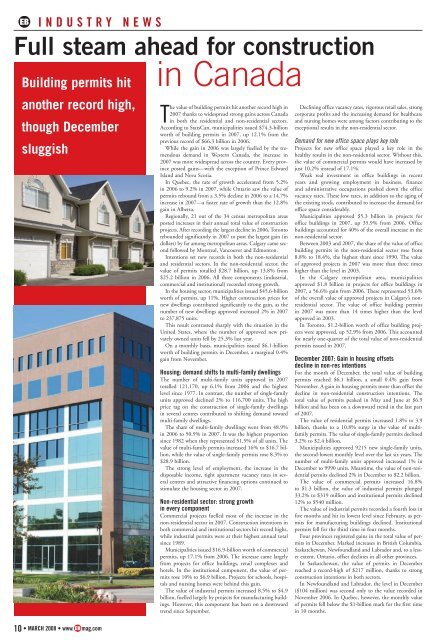Page 11 Page 34 Page 22 - Electrical Business Magazine
Page 11 Page 34 Page 22 - Electrical Business Magazine
Page 11 Page 34 Page 22 - Electrical Business Magazine
- No tags were found...
You also want an ePaper? Increase the reach of your titles
YUMPU automatically turns print PDFs into web optimized ePapers that Google loves.
INDUSTRY NEWSFull steam ahead for constructionBuilding permits hitanother record high,though Decembersluggishin CanadaThe value of building permits hit another record high in2007 thanks to widespread strong gains across Canadain both the residential and non-residential sectors.According to StatsCan, municipalities issued $74.3-billionworth of building permits in 2007, up 12.1% from theprevious record of $66.3 billion in 2006.While the gain in 2006 was largely fuelled by the tremendousdemand in Western Canada, the increase in2007 was more widespread across the country. Every provinceposted gains—with the exception of Prince EdwardIsland and Nova Scotia.In Quebec, the rate of growth accelerated from 5.2%in 2006 to 9.2% in 2007, while Ontario saw the value ofpermits rebound from a 3.5% decline in 2006 to a 14.7%increase in 2007—a faster rate of growth than the 12.8%gain in Alberta.Regionally, 21 out of the <strong>34</strong> census metropolitan areasposted increases in their annual total value of constructionprojects. After recording the largest decline in 2006, Torontorebounded significantly in 2007 to post the largest gain (indollars) by far among metropolitan areas. Calgary came secondfollowed by Montreal, Vancouver and Edmonton.Intentions set new records in both the non-residentialand residential sectors. In the non-residential sector, thevalue of permits totalled $28.7 billion, up 13.8% from$25.2 billion in 2006. All three components (industrial,commercial and institutional) recorded strong growth.In the housing sector, municipalities issued $45.6-billionworth of permits, up <strong>11</strong>%. Higher construction prices fornew dwellings contributed significantly to the gain, as thenumber of new dwellings approved increased 2% in 2007to 237,875 units.This result contrasted sharply with the situation in theUnited States, where the number of approved new privatelyowned units fell by 25.3% last year.On a monthly basis, municipalities issued $6.1-billionworth of building permits in December, a marginal 0.4%gain from November.Housing: demand shifts to multi-family dwellingsThe number of multi-family units approved in 2007totalled 121,170, up 6.1% from 2006 and the highestlevel since 1977. In contrast, the number of single-familyunits approved declined 2% to <strong>11</strong>6,700 units. The highprice tag on the construction of single-family dwellingsin several centres contributed to shifting demand towardmulti-family dwellings.The share of multi-family dwellings went from 48.9%in 2006 to 50.9% in 2007. It was the highest proportionsince 1982 when they represented 51.5% of all units. Thevalue of multi-family permits increased 16% to $16.7 billion,while the value of single-family permits rose 8.3% to$28.9 billion.The strong level of employment, the increase in thedisposable income, tight apartment vacancy rates in severalcentres and attractive financing options continued tostimulate the housing sector in 2007.Non-residential sector: strong growthin every componentCommercial projects fuelled most of the increase in thenon-residential sector in 2007. Construction intentions inboth commercial and institutional sectors hit record highs,while industrial permits were at their highest annual totalsince 1989.Municipalities issued $16.9-billion worth of commercialpermits, up 17.1% from 2006. The increase came largelyfrom projects for office buildings, retail complexes andhotels. In the institutional component, the value of permitsrose 10% to $6.9 billion. Projects for schools, hospitalsand nursing homes were behind this gain.The value of industrial permits increased 8.5% to $4.9billion, fuelled largely by projects for manufacturing buildings.However, this component has been on a downwardtrend since September.Declining office vacancy rates, vigorous retail sales, strongcorporate profits and the increasing demand for healthcareand nursing homes were among factors contributing to theexceptional results in the non-residential sector.Demand for new office space plays key roleProjects for new office space played a key role in thehealthy results in the non-residential sector. Without this,the value of commercial permits would have increased byjust 10.2% instead of 17.1%.Weak real investment in office buildings in recentyears and growing employment in business, financeand administrative occupations pushed down the officevacancy rates. These low rates, in addition to the aging ofthe existing stock, contributed to increase the demand foroffice space considerably.Municipalities approved $5.3 billion in projects foroffice buildings in 2007, up 35.9% from 2006. Officebuildings accounted for 40% of the overall increase in thenon-residential sector.Between 2003 and 2007, the share of the value of officebuilding permits in the non-residential sector rose from8.8% to 18.4%, the highest share since 1990. The valueof approved projects in 2007 was more than three timeshigher than the level in 2003.In the Calgary metropolitan area, municipalitiesapproved $1.8 billion in projects for office buildings in2007, a 56.6% gain from 2006. These represented 53.6%of the overall value of approved projects in Calgary’s nonresidentialsector. The value of office building permitsin 2007 was more than 14 times higher than the levelapproved in 2003.In Toronto, $1.2-billion worth of office building projectswere approved, up 52.9% from 2006. This accountedfor nearly one-quarter of the total value of non-residentialpermits issued in 2007.December 2007: Gain in housing offsetsdecline in non-res intentionsFor the month of December, the total value of buildingpermits reached $6.1 billion, a small 0.4% gain fromNovember. A gain in housing permits more than offset thedecline in non-residential construction intentions. Thetotal value of permits peaked in May and June at $6.9billion and has been on a downward trend in the last partof 2007.The value of residential permits increased 1.8% to 3.9billion, thanks to a 10.8% surge in the value of multifamilypermits. The value of single-family permits declined3.2% to $2.4 billion.Municipalities approved 9215 new single-family units,the second-lowest monthly level over the last six years. Thenumber of multi-family units approved increased 1% inDecember to 9990 units. Meantime, the value of non-residentialpermits declined 2% in December to $2.2 billion.The value of commercial permits increased 16.8%to $1.3 billion, the value of industrial permits plunged33.2% to $319 million and institutional permits declined12% to $540 million.The value of industrial permits recorded a fourth loss infive months and hit its lowest level since February, as permitsfor manufacturing buildings declined. Institutionalpermits fell for the third time in four months.Four provinces registered gains in the total value of permitsin December. Marked increases in British Columbia,Saskatchewan, Newfoundland and Labrador and, to a lesserextent, Ontario, offset declines in all other provinces.In Saskatchewan, the value of permits in Decemberreached a record-high of $217 million, thanks to strongconstruction intentions in both sectors.In Newfoundland and Labrador, the level in December($104 million) was second only to the value recorded inNovember 2006. In Quebec, however, the monthly valueof permits fell below the $1-billion mark for the first timein 10 months.10 • MARCH 2008 • www. mag.com
















